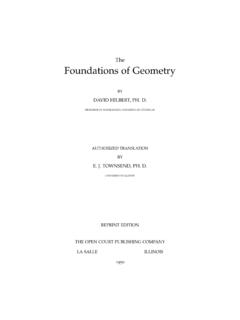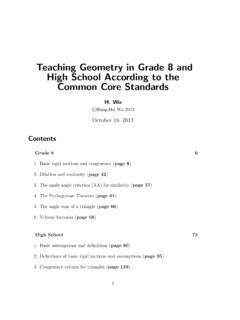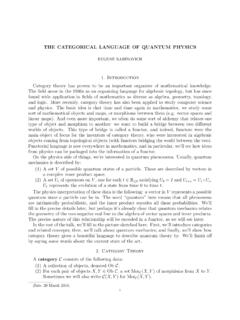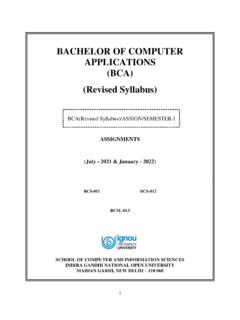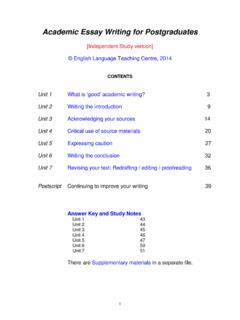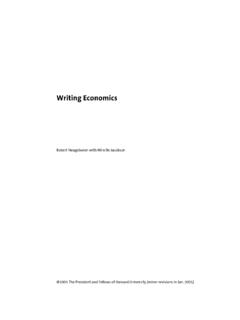Transcription of Solutions to Assignment-1 - University of California, Berkeley
1 Solutions to Assignment-1 . In each of the following, only use (and indicate) theorems or axioms introduced in the lectures.. 1. (a) Show that 12 is irrational.. Solution: If not, then 6 = p/q where p and q have no common factors. Squaring, p2 = 12q 2 . Since 3 divides the right-hand side, it ought to also divide the left hand side, and hence must divide p. So let p = 3m. Then we have 9m2 = 12q 2 or 3m2 = 4q 2 , and so 3|4q 2 . But since 3 is a prime and does not divide 4, we must have that 3|q 2 or 3|q. But then 3 is a common factor between p and q, a contradiction!. Note. One cannot argue using divisibility with respect to 2 (try it!!) as in the proof of irrationality of 2. (b) Now consider the set E := { Q | 2 < 12}. Given any positive number Q such that 2 < 12, find an explicit rational number > 0 (depending of course on ), such that ( + )2 < 12. Solution: We need an > 0 such that ( + )2 < 12.
2 Note that ( + )2 = 2 + 2 + 2 . Now, since 2 < 12, clearly, < 4. If we then pick < 1, since 2 < , we automatically have ( + )2 < 2 + 9 . Now, if pick smaller than (12 2 )/9, we will have ( + )2 < 12. So we can take 12 2 . < min 1, . 9. (c) Similarly, if 2 > 12, and < 4, find an explicit positive rational number such that ( )2 > 12. and yet is an upper bound of E. Solution: We argue as above, noting that ( )2 = 2 2 + 2 2 8 + 2 > 2 8 , since < 4 and 2 > 0. Since we want this to be greater than 12, we simply choose 2 12. = . 8. This solves the first part. Claim. With as above, is also an upper bound for E. Firstly, note that > 0. So if the claim is false, then there exists a positive E such that . Squaring both sides preserves the inequality since both numbers are positive, and we obtain 2 ( )2 . This is clearly a contradiction, since the left hand side 2 < 12, by the definition of E, while the right hand side by construction is bigger than 12.
3 1. (d) Hence show that E has no least upper bound in Q. Solution: Suppose = sup E Q. There are three cases. 2 < 12. Then by definition E. By part(b), there exists an > 0 such that + E, and so is not an upper bound for E. A contradiction. 2 > 12. By part(c), there exists an > 0 such that is also an upper bound for E, and so which contradicts the fact that is the least upper bound. 2 = 12. By part(a), this is not possible for a rational number . So all three cases give contradictions, and hence E does not have a supremum in Q. 2. Let a, b R. (a) Show that |b| a if and only if a b a. Solution: Every if and only if proof has two directions. = . So we assume that |b| a. In particular this implies that a 0. We proceed by contradiction. Suppose b > a. Then b > 0, and so |b| = b contradicting the assumption that |b| a. Similarly, if b < a, then b < 0 and so |b| = b, and so b a, or b a which is a contradiction.
4 = . Now we assume that a b a. If b 0, then |b| = b a. If b < 0, then |b| = b. Since b a, b a. So again |b| a. (b) Show that ||b| |a|| |b a|. Solution: By the regular triangle inequality, |a| |a b| + |b|, and so |b| |a| |b a|. Again by triangle inequality, |b| |b a| + |a|, and so |b| |a| |b a|. That is, |b a| |b| |a| |b a|. Then by part(a) above, ||b| |a|| |b a|. 3. Let A, B R. (a) If sup A < sup B, then show that there is some b B which is an upper bound for A. Solution: Since sup A < sup B, there exists a such that sup A < < sup B. But then < . for all A. On the other hand cannot be an upper bound for B, and so there exists b B. such that b. Then this b is clearly an upper bound for A. (b) Show, by providing an example, that this is not necessarily the case if sup A sup B. Solution: Let 1. A = { | n N}, B = [ 1, 0). n Then sup A = sup B = 0, but no element of B is an upper bound for A.]
5 4. Let a < b be real numbers, and consider the set T = Q [a, b]. Show that inf T = a and sup T = b. 2. Solution: We show that sup T = b. Clearly b is an upper bound for T . Suppose is another upper bound, and suppose < b. Then by the density of rationals, there exists a rational r Q such that < r < b. Then r T and cannot be an upper bound. Contradiction! 1. 5. (a) Let a, b R such that a b + n for all n N. Show that a b. Solution: If not, then a > b or equivalently a b > 0. Then by the corollary to the Archimedean property, there exists an integer n such that a b > 1/n, contradicting the hypothesis that a b + n1 for all n. Hence we must have that a b. 1. (b) Show that if a > 0, then there exists a natural number n N such that n a n. Solution: By the Archimedean property, there exist natural numbers n1 and n2 such that 1. < a and a < n2 . n1. Now let n = max(n1 , n2 ).
6 Then 1/n 1/n1 and n n2 , and so 1. a n. n (c) Let a, b R such that a < b. Use the denseness of Q to show that there are infinitely many rationals between a and b. Solution: By the density of Q, there is at least one rational number in (a, b). Call this r1 . Then again by density of rationals, there is at least one rational in (r1 , b); call this r2 . Having picked r1 , r2 , , rn , let rn+1 be a rational number between (rn , b). So we have an infinite collection of rationals r1 , r2 , between a and b. 6. Let A and B be non-empty subsets of R, and let A + B := {a + b | a A, b B}. That is, A + B is the set of all sums a + b, where a A and b B. (a) Show that sup(A + B) = sup A + sup B. Note. You need to separately consider the case when at least one of the two supremums on the right is . Solution: Let sup A = and sup B = . Suppose , < . Clearly + is an upper bound for A+B, and so sup(A+B) +.
7 Next, for any > 0, there exists an a A and a b B such that . a , b . 2 2. So there exists a + b A + B satisfying a + b + . Taking supremum, sup(A + B) + . Since this is true for all > 0, we must have sup(A+B) + and so sup(A+B) = + . Suppose = . Then A is unbounded, and so must A + B. = . Same argument. 3. (b) inf(A + B) = inf A + inf B. Solution: Follows from the facts that inf E = sup( E), (A+B) = A+( B), and part(a). above. 7. For each sequence, find the limit, and use the definition of limits to prove that the sequence does indeed converge to the proposed limit. Note that this means, given an > 0, you need to write down an N for which the definition of convergence works. Try to make the dependence of N on as explicit as possible. 3n + 1. (a) lim . n 6n + 5. Solution: Discussion. (3n + 1)/(6n + 5) = (3 + 1/n)/6 + 5/n. As n , clearly this should tend towards 3/6 or 1/2.
8 To prove that this is the limit we need to estimate 3n + 1 1 3. = . 6n + 5 2 2(6n + 5). Our aim should to be to make the right hand side smaller than a given > 0. j 12 + 4n k (b) lim , where for any x R, the floor function bxc is the greatest integer smaller than or n 3n equal to x (for instance, b c = 3, b = 3). Solution: There exists an N such that for all n > N , 4 2. < . n 3. Then for any n > N , j 12 + 4n k j4 4k = + = 1. 3n 3 n In particular, given any > 0 if n > N , j 12 + 4n k 0= 1 < , 3n and hence the limit exists and is 1. 8. Give an example of each of the following or state that such a request is impossible by referencing the correct theorem. (a) Sequences {xn } and {yn } that both diverge, but {xn + yn } converges. Solution: xn = n, yn = n. (b) Sequence {xn } converges and {yn } diverges, but {xn + yn } converges. Solution: This cannot happen. If xn + yn converge to A and xn converges to B, then by the addition theorem for limits, yn = (xn + yn ) xn converges to A B.
9 (c) Two sequences {xn } and {yn } where {xn yn } and {xn } converge, but {yn } diverges. Solution: xn = 1/n and yn = ( 1)n . 4. (d) Let k N be fixed. Then sequence {an } . n=1 converges but {an+k }n=1 might not converge, or even if it converges, might not converge to the same limit. Solution: Suppose lim an = L. n . Claim. If k is fixed, then an+k L as n . Proof. Since an L, given any > 0, there exists N such that n > N implies |an L| < . But then n > N = |an+k L| < , since n + k > N . 9. Let {xn } and {yn } be two sequences, and let {zn } by the shuffled sequence {x1 , y1 , x2 , y2 , }. (a) Find a general formula for zn . Solution: (. xm , n = 2m 1. zn =. ym , n = 2m. (b) Show that {zn } converges if and only if both {xn } and {yn } converge to the same value. Solution: = . Suppose zn converges to L. Let > 0. Then there exists an N such that for all n > N, |zn L| <.)
10 If n = 2m 1 or n = 2m, then n > N implies that m > (N + 1)/2. Then from part(a), for all m > (N + 1)/2, |xm L| < , |ym L| < , and so lim xn = lim yn = L. n n . = Suppose limn xn = limn yn = L. Let > 0. Then there exists an N1 such that for all m > N1 , |xm L| < . Similarly, there exists an N2 such that for all m > N2 , |ym L| < . Let N = max(2N1 1, 2N2 ). 10. Let a1 = 1 and 1. an+1 = (an + 1). 3. for n > 1. (a) Find a2 , a3 and a4 . Solution: a2 = 2/3, a3 = 5/9, a4 = 14/27. (b) Use induction to show that an > 1/2 for all n. 5. Solution: For the base case, n = 1, clearly a1 = 1 > 1/2. Suppose an > 1/2. Then an + 1 3/2 1. an+1 = > = . 3 3 2. (c) Show that {an } is a convergent sequence and compute it's limit. Solution: From part(a) it seems that the sequence is decreasing. Let us try to prove that. Since an > 1/2, 1 < 2an and so, we have an + 1 an + 2an an+1 = < = an.

